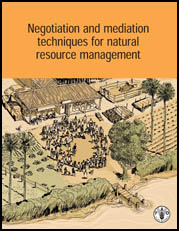 |
Negotiation and mediation techniques for
natural resource management
by
Antonia Engel
Benedikt Korf
Prepared in the framework of the
Livelihood Support Programme (LSP)
An interdepartmental programme for improving
support for enhancing livelihoods of the rural poor
|
|
FOOD AND AGRICULTURE ORGANIZATION OF THE UNITED NATIONS
ROME, 2005
|
| |
Table of Contents
|
|
The designations employed and the presentation of material in
this information product do not imply the expression of any opinion whatsoever
on the part of the Food and Agriculture Organization of the United Nations
concerning the legal or development status of any country, territory, city or
area or of its authorities, or concerning the delimitation of its frontiers or
boundaries. |
All rights reserved. Reproduction and dissemination of material in this information
product for educational or other noncommercial purposes are authorized without
any prior written permission from the copyright holders provided the source
is fully acknowledged. Reproduction of material in this information product
for resale or other commercial purposes is prohibited without written permission
of the copyright holders. Applications for such permission should be addressed
to the Chief, Publishing Management Service, Information Division, FAO, Viale
delle Terme di Caracalla, 00100 Rome, Italy or by e-mail to copyright@fao.org
© FAO 2005
Foreword
Acknowledgements
Introduction
What this guide is about
Who the guide is for
Objectives of the guide
Effectiveness of consensual
negotiations
What is in the guide?
How to use the guide
Glossary
SECTION 1: An introduction to
natural resource conflicts, collaborative management and sustainable livelihoods
1.1 What are community-based natural
resource conflicts?
1.2 Collaborative natural resource
management and conflict
1.3 Natural resource conflicts and
sustainable livelihoods
Section summary
SECTION 2: Managing conflict
2.1 The nature of
conflict
2.2 Different options for managing
conflict
2.3 Alternative conflict management
methods: negotiation and mediation techniques
2.4 Mediation in direct and non-direct
dealing cultures
Section summary
SECTION 3: Process map for consensual
negotiations
3.1 The role of a third party in
consensual negotiations
3.2 The ten steps of conflict
management
3.3 Process management
Section summary
SECTION 4: Entry
4.1 Why careful entry is
essential
4.2 Step 1: planning the
entry
4.3 Step 2: entering the conflict
setting
4.4 Step 3: preliminary conflict
assessment
Section summary
SECTION 5: Analysing conflict
5.1 Why conflict analysis is
essential
5.2 Conflict analysis as a
process
5.3 Tools in conflict
analysis
5.4 Conflict issues and root cause
analysis
5.5 Identifying and analysing
stakeholders
Section summary
SECTION 6: Broadening stakeholder
engagement
6.1 Why stakeholder engagement is
important
6.2 Step 4: deeper engagement -
stakeholders analyse the conflict
6.3 Step 5: generating and assessing
settlement options
Section summary
SECTION 7: Negotiations and building
agreements
7.1 Why negotiations and agreements
are important
7.2 Step 6: preparing
negotiations
7.3 Step 7: mediating
negotiations
7.4 Step 8: designing the
agreement
Section summary
SECTION 8: Exit
8.1 Why an exit strategy is important
8.2 Step 9: monitoring and implementing agreements
8.3 Step 10: exploring exit strategy
Section summary
ANNEXES
ANNEX I: Collaborative natural
resource management
Collaborative management
The policy framework: are the circumstances right?
Conclusion
ANNEX II: Field guide to conflict
analysis
Analysing conflict
Tools in conflict analysis
Core tool 1: Root cause analysis
Core tool 2: Issue analysis
Core tool 3: Stakeholder identification and analysis
Core tool 4: Analysing the 4Rs - stakeholder
rights, responsibilities, returns and relationships
Complementary tool 5: Conflict time line
Complementary tool 6: Mapping conflicts over
resource use
ANNEX III: Case studies
Case study 1: Management of Bawumpila Community
Forest
Case study 2: Conflict on the diversion of Bosoko
river in the Amansuri wetland
References
Back Cover
